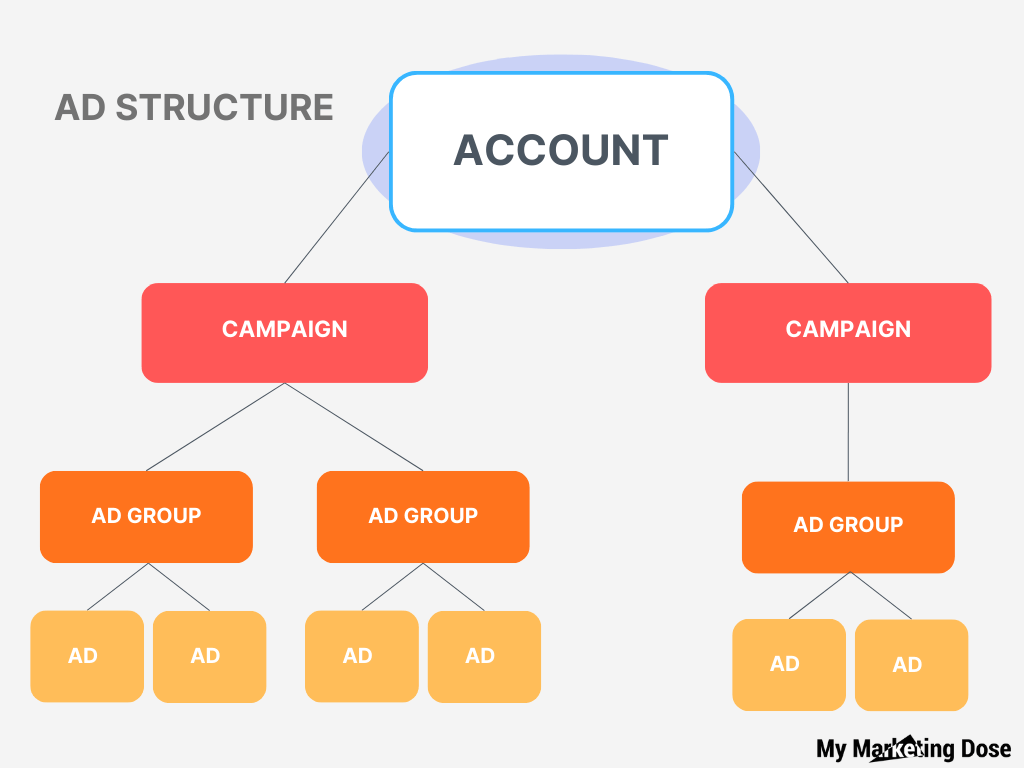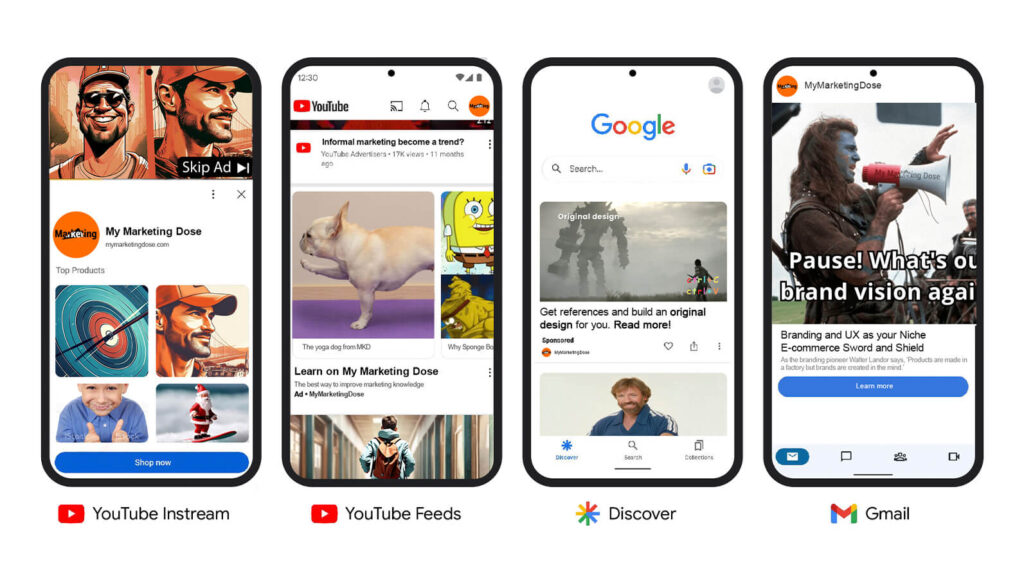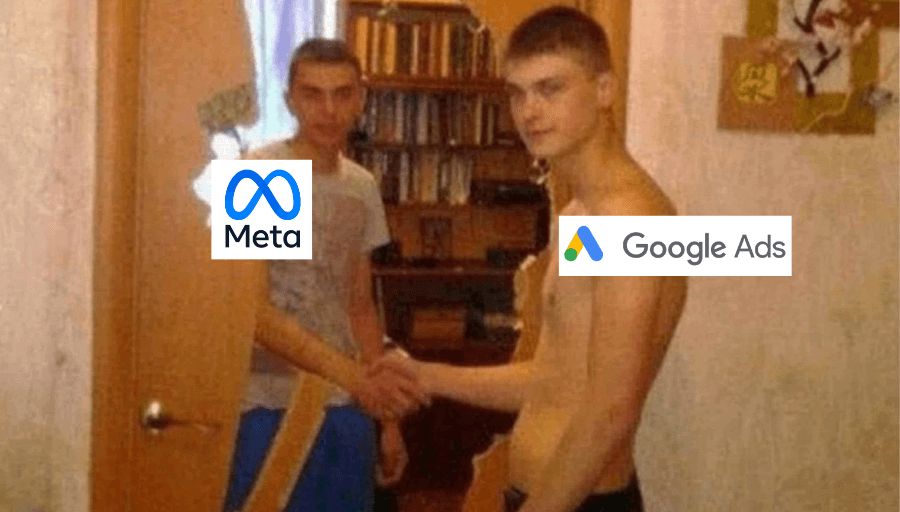Advertising is basically buying a privileged space online. In a scenario where many competitors are fighting for that, there are various techniques to enhance your company in that competitive arena and start on paid media.
Yes, you can compete with big players in advertising. But maybe it isn’t a good idea focusing only on the “budget battle” cause there is always a bigger fish and, sometimes, that fish is a freaking magnate whale.
If you are on the internet, whether you have an online store, a services website, or any variation of that, you have probably already heard about Google Ads and Meta Ads for advertising. But is there logic in thinking about which one is better?
First of all, let’s understand the basis of each platform.
Understanding Google Ads
With the tool, companies can pay to stand out on search engine results pages and other placements provided by Google.
Especially in active search for a product and service. It can be a top-of-the-funnel channel, but it’s typically used in the middle and bottom. There is an amazing post about marketing funnel for you, click here to know more.
Independent of that, to launch a google ad campaign, you’ll need to define an objective. You can set the following:
- Sales
- Leads
- Website traffic
- App promotion
- Awareness and consideration
- Local store visits
You can even do a campaign without goals’ guidance.
Each objective will help further to accomplish your goals.
For example, if you want to drive more orders to your ecommerce, you can select the “Sales” objective. Setting up your objective, you’ll have recommended features and settings on your campaign that can help on your goal to drive more sales.
Exploring Campaign Types
A campaign consists in a set of ad groups with configuration of creatives, keywords, budget, bid strategies, extensions, localization targeting and segments.
Basic structure of an ad campaign:

Remembering that this image shows a basic structure of the pattern of Google Ads and Meta Ads. You can have many ad groups and ads in the same campaign to test and achieve the goal in many ways.
For example, you can set up two ads for the same ad group. One having a more appelative approach, with sales terms and vivid creatives, and the second with more balanced terms, containing more product info. Then, given the right time, you’ll be able to analyze which is performing better and make adjustments based on that data.

Now you know the basic structure of an ad campaign and even a tip to compare ads performances, let’s dive into the campaigns types:
Performance Max – “Drives sales by reaching the right people wherever they’re browsing”. Has inventory across Search, YouTube, Display, Discover, Gmail and Maps.
It can be considered the “new shopping campaign”.

Performance Max uses Google AI across bidding, budget optimization, audience, creatives, attribution and more.
To build a Performance Max Campaign, or what the intimate one calls ‘PMAX’, you’ll need to provide images, texts, videos and even products listing groups in case you have an ecommerce.
Resuming, it is a very complete campaign with AI optimization. Overpowered, right?
Search – “Drives sales on Google Search with text ads”.
Targets people actively searching for your specific products and services.
This is the classic text campaign when we search online. Search campaigns are set up with keywords that users search for.

A tip to not waste money with search campaigns is to use negative keywords. With negative keywords, your campaign will not consume ad budget for irrelevant keywords.
Display – “Reach potential customers across sites and apps with your creative”.
Display campaigns showcase ads to audiences who are browsing content on YouTube, Gmail and in the Google Display network, with millions of websites and apps.

Display campaigns are a good way to appear on diverse sites. Is very common to aly display campaigns with Remarketing strategy, using a list of your website users and showcasing ads and “brand hits” across users navigation.
Shopping – “Promote your product on Google Search with your Google Merchant Center data”.

Use Merchant Center feeds of products to display ads on shopping search areas.
Shopping campaigns are slowly being replaced by the overpowered PMAX, but still a choice on Google’s catalog.
Video – “Drive sales on YouTube with your video ads”.
Gives the possibility to create relevant videos with diverse ad formats to engage clients in various ways on YouTube and Google video partners.

Organize your ads into groups based on similar themes. For instance, if you sell desserts, beverages, and snacks, create separate ad groups for each category. This helps you target your audience more effectively.
And if you sell desserts, beverages, and snacks, what are you waiting to send me one?
Demand Gen – “Drive demand and conversions on YouTube, Discover, and Gmail with image and video ads”.
Flows similar to buying on social media and has the feature to use product feeds on YouTube, Gmail, Discover.

And yes, you can run Remarketing with Demand Gen campaigns, it is like your secret weapon. It helps you reconnect with users who’ve already checked out your content or products on Google. Now, here’s the cool part: when you blend Remarketing with Demand Gen tricks like personalized ads and AI powered bidding, you’re basically creating super effective ads.
A portion of the information, mainly the campaign’s definition, was obtained from Google Ads documentation (https://ads.google.com/home/), with the remaining content developedthrough original analysis and interpretation.
Meta Ads: Targeting the Right Audience
Meta Ads have a similar ad structure to Google Ads, but the goals and approach here can be totally different.
So, Meta ads are basically those ads you see on Facebook, Instagram, WhatsApp, and Messenger – you know, all those apps owned by Meta (formerly known as Facebook). They’re everywhere, right?
These ads are super targeted, meaning they’re tailored to reach specific people based on what they like, where they live, and what they do online. They’re a big deal in the world of online marketing because they help businesses connect with the right audiences.
Introducing Meta Ads
To understand better how an ad works on Meta, we’ll dive into the objectives:
Simplified ad objective | Your business goal is to: | Original ad objective |
Awareness | Bring awareness to your business. This objective will help you reach the largest number of people who are most likely to remember your ad. If your business is brand new or has recently changed names, awareness may help potential customers become more familiar with your business. | Brand awareness Reach Video views Store traffic |
Traffic | Increase traffic to an online destination of your choice. Send people to a destination, like your Facebook Page or shops on Instagram, website or app. If you’re having a flash sale in your shop or want to send potential customers to a web page that describes your services, this may help drive traffic to those destinations. | Traffic |
Engagement | Find the people most likely to engage with your business online, send a message or take desired actions on your ad or Page. If you want people who are interested in your products or services to start a conversation via Messenger, this objective can reach potential customers that are more likely to do so. | Engagement Video views Messages Conversions |
Leads | Collect leads for your business or brand via messages, phone calls or signups. If you want potential customers to sign up for a monthly newsletter, leads can help you reach people who want to share their information and learn more about your business. | Lead generation Messages Conversions |
App promotion | Get people on mobile devices to install or take a specific action within your app. If you want potential customers to make a purchase through your app or try a new feature, you can create an app promotion campaign. | App installs |
Sales | Find people likely to purchase your goods or services. If you want to reach people who are most likely to make a purchase, such as through an ecommerce site, you can use the sales objective. You can also optimize for other actions, such as adding an item to cart. | Conversions Catalog sales |
This content above is provided by facebook website (yes Mark, you can have your credit): https://www.facebook.com/business/help
As we can see, there are various objectives to build our ad campaign on meta. And besides selecting an objective, your ad can feature images, videos, carousels and collections.

Choosing the Right Platform
Which platform is better for starting your ad strategy? Now you know the basics about Google Ads and Meta Ads, let’s discuss the advantages of each one.
When you’re searching for something on Google, you commonly have something in mind, right? This is the great power of Google Ads: users are effectively searching the subject. Advertising where people are looking to buy is really a shot to the right target. In addition, Google’s vast inventory leverages its integrated ecosystem.
One of the advantages of Facebook Ads is to attract potential clients in a starting buying stage. That occurs because the ad is present without the need of searching. You are seeing photos of friends and, bam, an ad appears based on the algorithm interests. Besides that, an ad on Facebook or Instagram, can make the user follow the page and build loyalty over time.
Both are capable of doing Remarketing ads.
Resuming, if your target is people more forward on the Conversion Path, Google Ads is a good ally. If it is focused on the top funnel or awareness, start with Facebook Ads.
However, a crucial point to note in this conclusion is that it’s ideal to allocate your budget to both platforms.
Each company or brand possesses unique characteristics that aid in understanding how to implement budget allocation. Some companies use 80/20, some use 60/40, and there are enormous variants for that including other platforms like TikTok, Linkedin, Snapchat and more (that is a great subject for a future topic). The optimal allocation of advertising budget depends on various factors, So start testing, discover what brings you closer to your goal.
Attention to Conversion Window and Attribution Model
Of course that you’ll look into these ads platforms to enhance your campaigns and analyze results, but each one has their own attribution model. It’s essential to clarify that advertisers can customize attribution models within both platforms
Both can count a conversion in 24 hours when the user only sees the ad, and for users that clicked on the ad, the conversion can reach a window of 7 days to 30 days to be counted on the platforms. What a big conversion window, right?
On analyzing paid media results, I would tip you on having a unique holistic centralizer: Google Analytics 4 (GA4).
Analyzing Results with GA4

If each platform has their own attribution model, it gets a little difficult to understand for a fact who owns the final conversion. Based on that, GA4 can contribute to your analysis having a singular “point of view”.
GA4 uses the Data-Driven Attribution model (DDA), which attributes a conversion to the most relevant source, using a machine learning algorithm to understand all touchpoints and distribute the credit in, as we can call: a more agnostic way. It’s not the only option for attribution modeling, but it’s the standard and more used model.
On Meta and Google platforms, still counting the conversion to each one, but in GA4 using DDA model, the conversion goes to the most relevant source.
So, the main point here is that you can have an overview of all your paid media results using the same attribution model.
Understanding Conversion Paths
“But host of My Marketing Dose, I’m analyzing that facebook almost isn’t converting sales on my GA4, should I stop investing there?”
First of all, are those tags, from Meta and Google, well configured? If positive, let’s proceed.
Last, but not least important, I strongly recommend analyzing the conversion path report.
This report shows you the participation based on touchpoints (ad interactions) of each source on the conversion path. Is an insightful way to understand how relevant your media sources are along the conversion. You can also filter by campaign, medium and channel groups.

As the example above shows us, the first row (red) shows a conversion totally counted to facebook.
The next one (green), shows 3 touchpoints to google, 2 for facebook and 12 to google at the end. Based on touchpoints and the DDA model, Google has 99% of the conversion credit.
The last one (blue), shows us that google was the first and the last touchpoints, but Facebook in the middle gave more relevant interactions, having 80% of the credit.
Concluding, even though Facebook does not have all conversions, this paid media source indeed impacts the consumer through the conversion path. Remember the importance to understand the impact of each media and sources to cover interested users all the way.




